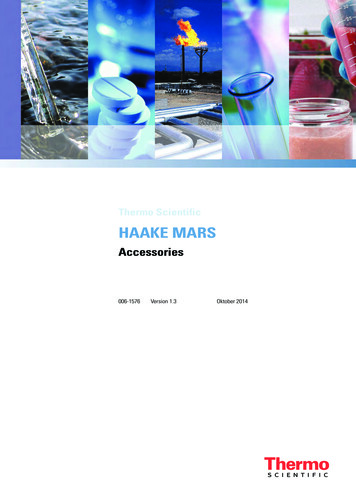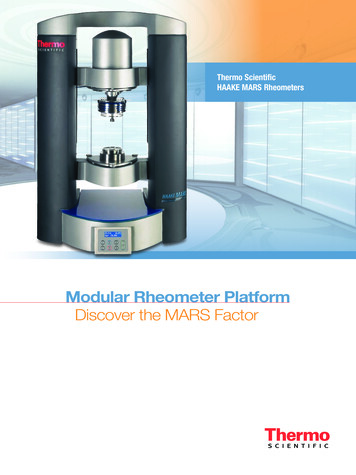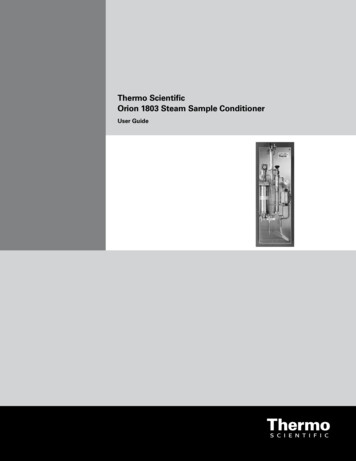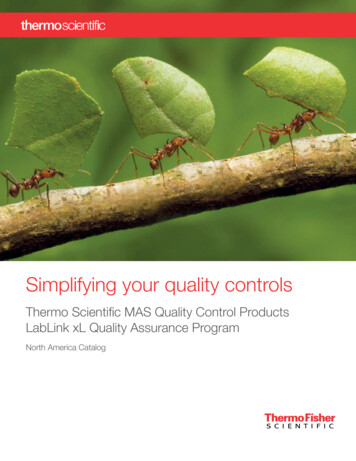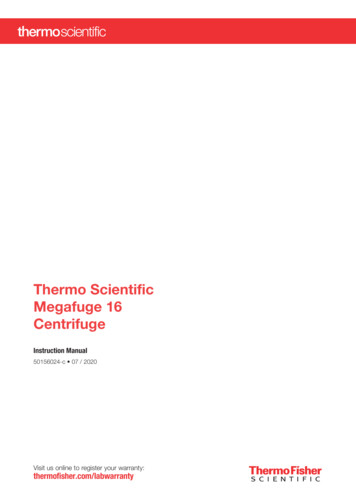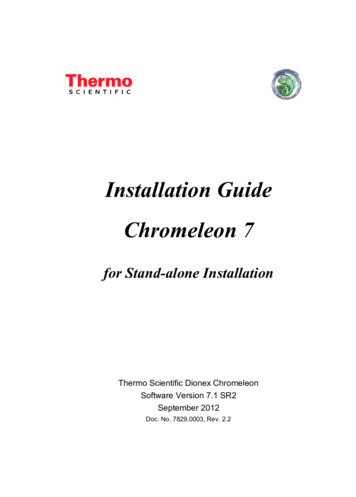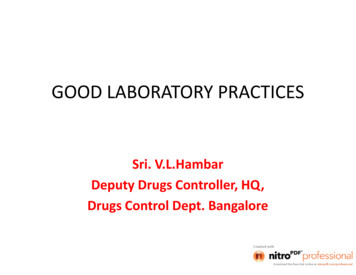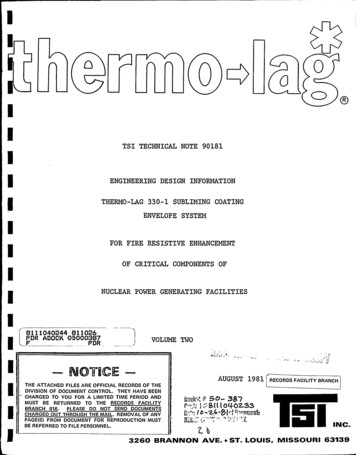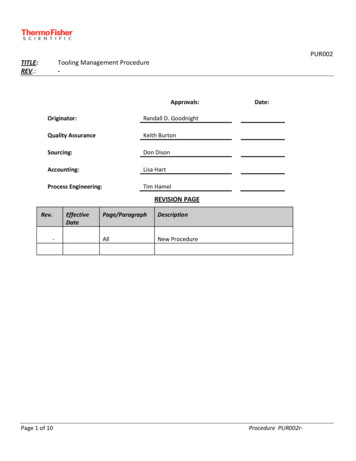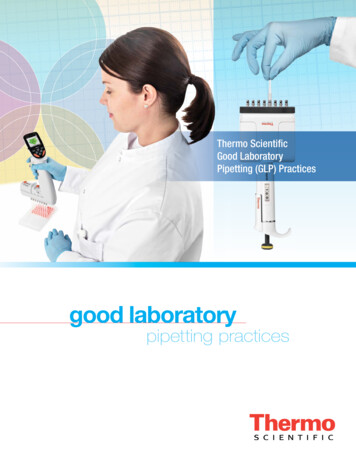
Transcription
Thermo ScientificGood LaboratoryPipetting (GLP) Practicesgood laboratorypipetting practices
Table of contents:Leading provider ofinnovative pipetting systemsTOOLSYou can improve accuracy and precisionwhen you combine the right pipettingtools, technique, ergonomics, andservice with the most critical factor: theskill and expertise of the operator. Let usshow you how with over 50 years of liquidhandling experience.TECHNIQUESERGONOMICSThis comprehensive Good Laboratory Pipetting (GLP)guide will help you achieve better results by providing tipson advancing your skills so you can handle anything.1Liquid handling tool selection –Choose the best option, from pipette to tip2Proper pipetting techniques –Improve your results with proper technique3Ergonomics – Ensure your dailyenvironment fits you comfortably4Maintenance and service –Secure the quality of your resultsSERVICEHistory of Thermo Scientific Innovation1Variable r TipsMultichannelPipettesAdjustable TipSpacing PipetteExtendedLength TipsElectronic Pipettewith Trigger ActionNesting Filter TipReload PackagingInterlockingClipTipTechnology
CHAPTER 1Liquid handling tool selection –Choose the best option, frompipette to tipPistonAir Displacement Pipettes:Air displacement pipetting is highly accurate for standard pipettingapplications. However, temperature and atmospheric pressure, aswell as the specific gravity and viscosity of the solution, may affectthe performance of air displacement pipettes.PipettetipHow air displacement pipettes workAspirating the liquid (steps 1-3)Dispensing the liquid (step 4)1. The piston moves to the appropriateposition when the volume is set.2. When the operating button ispressed to the first stop, the pistonexpels the same volume of air asindicated on the volume setting.3. After immersing the tip into theliquid, the operating button isreleased. This creates a partialvacuum, and the specified volume ofliquid is aspirated into the tip.There are two types of pipettes:Air displacement pipettes meant for general use withaqueous solutionsPistonPositive displacement pipettes used for highly viscous and volatileliquids4. When the operating button ispressed to the first stop again, theair dispenses the liquid. To emptythe tip completely, the operatingbutton is pressed to the secondstop (blow-out).Positive Displacement Pipettes:Positive displacement pipetting is based on direct contact of thepiston with the liquid. The aspirated liquid amount depends on thedimensions of the cylinder or capillary and the movement distanceof the piston. In positive displacement pipettes the tips contain boththe cylinder/capillary and the piston.How positive displacement pipettes workThermo Scientific F1-ClipTip 12-Channel PipetteThermo Scientific Finnpipette Stepper PipetteBoth pipette types have a piston that moves in a cylinder or capillary.In air displacement pipettes, a certain volume of air remains betweenthe piston and the liquid. In positive displacement pipetting, the pistonis in direct contact with the liquid.1. The piston movesdown inside thetip to make directcontact with thesample.2. The piston movesup to draw thesample into the tip.3. When dispensing,the pistondescends and theselected volume isdispensed.
CHAPTER 1Liquid handling tool selectionPipette tip selection – Select the correct tip forideal sample recoveryThere is a pipettingsystem for virtuallyevery application andrequirement. The typeof experiment you areperforming and thephysical propertiesof the liquid willdetermine the correctpipette tip to use.Low Retention Pipette TipsUtilizing polymer technology makes the inner surface of the pipettetip more hydrophobic, resulting in a significant reduction in sampleloss due to adhesion. Benefits include improved sample delivery andconservation of expensive reagents.Specialty TipsSpecialty tips are designed for unique pipettingapplications to save time, reduce contamination,and increase accuracy, precision, and productivity.Standard TipsA standard tip is a multi-purpose tip for many laboratory applicationswith a variety of performance requirements that range from highaccuracy to reagent dispensing with greater tolerance. Sterile standardtips are available for applications demanding the highest level of purity.Wide Orifice TipsSterile Filter TipsA filter tip is beneficial when the assay issensitive to cross-contamination, or if thesample can contaminate the lower part ofthe pipette. The filter prevents liquid fromaccidentally splashing the inside of the pipette,and reduces aerosols from penetrating thepipette tip cone during pipetting. Filter tips arerecommended for low volume applicationsin genetic studies, forensics, PCR, andradioisotope sampling. They are availableThermo Scientific with either self-sealing barrier or standardART tips filter tips – both of which are designed toWatch how ARTprevent cross-contamination.barrier tips workNO contaminationSelf-sealing barrierAerosol contaminationSampleWide orifice tips feature a distal end orifice that is nearly 70 percentlarger than that of a standard pipette tip. These tips provide the addedflexibility required for handling difficult-to-pipette samples. They aredesigned for researchers working with macromolecules like genomicDNA and are especially critical for transferring fragile cellular samplessuch as macrophages, hybridomas, and hepatocytes, as well as otherviscous materials.Did you know that we have the broadestselection of pipette tips?Learn more about Thermo Scientific ClipTip,Finntip, ART, QSP* tips, and others atwww.thermoscientific.com/pipettetips*Available in certain countriesExtended Length Pipette TipsExtended length tips allow you to access the bottom of test tubes,reagent bottles, flasks, and other vessels without touching the shaft ofthe pipette against the side of the tube. This adds a layer of securityto protect samples, and virtually eliminates the chance of carryovercontamination. The longer tip length allows you to reach the bottomof long or narrow vessels that standard tips cannot reach.Choosing the correct tip for your applicationwill ensure ideal accuracy and precision.
CHAPTER 1Liquid handling tool selectionPipetting in DifferentApplicationsGel Loading TipsLoading acrylamide or agarose gels with standard pipette tipscan be a time-consuming process. Use the round gel loadingtips for agarose gels and specialized Ultra Round and Ultra Flatgel tips for your polyacrylamide gels to speed up theloading process.Improve Gel Loadingfor PCR AnalysisRead the app noteDue to their versatility and wide volume range, variable volume airdisplacement single-channel pipettes are the most used laboratoryinstruments. The same pipette can be used for multiple applications.Solvent Safe Carbon Filtered TipsSolvent-safe carbon filtered pipette tips are the best solution forhandling the pipetting rigors of Combinatorial Chemistry. Thesespecialized tips keep strong acids, bases, and aggressive organicsolvents from causing pipette failures and critical inaccuracies.Finnpipette F1 200 µlsingle channel pipetteIndividually Wrapped TipsFor extremely sensitive applications, single-wrapped tips areavailable. Individually-wrapped sterile tips are ideal for extremelysensitive applications requiring strict aseptic conditions.Genomic (wide orifice)Finnpipette F2 100 µl12-channel pipetteExtended lengthFinntip 1000 EXTE1-ClipTip Adjustable TipSpacing Equalizer 6-ch pipetteSerological pipets are used in cell and tissue culture applications, andin general laboratory liquid dosage when more than 1 ml volumes arepipetted. Serological pipets are made of glass or polystyrene. Plastic,disposable pipets are useful in applications where sterility is a requirement.Serological Pipet Fillers help to aspirate and dispense liquids accuratelyand with precision. The speed of both aspiration and dispensing can beadjusted separately to work with a variety of liquids.Manual Stepper pipettes are ideal for simple repetitive tasks with adispensing range up to 5 ml. A bulk reagent dispenser is a reliable andeasy tool for dispensing reagents directly from the reagent bottle.A dispenser offers speed and accuracy with no extra work steps ineveryday liquid dispensing.ART 20P Gel LoadingSolvent safeART 200 Solvent SafeIn applications where a lot of repetitive pipetting is performed, an electronicpipette provides a significant ergonomic benefit. Electronic pipettes areversatile laboratory workhorses that can be programmed to perform mostlaboratory tasks. The most commonly used function of electronic pipettesis the aliquoting of a reagent into multiple doses - multidispensing.By using a multichannel electronic pipette and repeat dispensingmodes in microplate filling, the time needed for filling the plate can bereduced from several minutes to less than a minute. Electronic pipettesthat offer adjustable tip spacing increase efficiency in samples transfersto move several samples at once between different labware formats.ART 200G Wide BoreGel loadingMultichannel pipettes are most commonly used in microplateapplications, such as ELISA, PCR, or cell culture. Manual multichannelpipettes offer instant usability for small scale multichannel work.Multichannel pipettes are available as 8- or 12-channel versions to workwith 96-well microplates, and as a 16-channel version to work with384-well microplates.Finnpipette Stepper
CHAPTER 1Liquid handling tool selectionThe System Solution – Increase reliability,reproducibility, better resultsClipTip Pipetting SystemDownload the brochure.ClipTip Pipette TipsF1-ClipTip Manual PipettesGood Laboratory Pipetting practices significantly influence the results of your liquid handling.The performance of your pipette is key and is a result of several factors, which include ensuringdesired specifications are met. Using the precisely manufactured pipette tips designed to worktogether as a system with your pipette greatly improves your results. A pipette’s performance isdirectly related to the quality of the pipette tip—a pipette is only as good as its tip.E1-ClipTip Electronic Pipettes,also available in AdjustableTip Spacing ModelsWe know it’s a challenge to ensure proper tip sealing in daily pipetting. The ideal solution is forthe pipette and tip to form a system that increases confidence in reproducibility, reduces forcesrequired to attach and detach the tip, and secures the best possible accuracy and precision.Did you know Thermo Scientific pipette tips are designed,developed, and manufactured to perfectly fitThermo Scientific pipettes?We know it’s a challenge to ensure a proper tip seal in daily pipetting. The ideal solution is for thepipette and tip to form a system to increase confidence in reproducibility, reduce forces requiredto attach and detach the tip, and secure the best possible accuracy and precision.Pipetting Systems provide: A significant improvement in pipetting performance for consistent and reproducibleliquid handling results. A reduction in attachment and ejection forces for ergonomic comfort. A decrease in visible pipette nose cone wear, which is common when using generic tips. An increase in the life of the pipette. Easy identification with color-coding of specific volume ranges for both pipettes and tips.Finnpipette Pipetting SystemDownload the brochure.Finntip Flex Pipette TipsFinnpipette F2 Manual PipettesFinnpipette F1 Manual PipettesFinnpipette Novus Electronic PipettesFinntip Pipette TipsBoth Thermo Scientific ClipTip and FinnpipetteSystems are designed and manufactured accordingto ISO 9001, ISO 14001, and ISO 13485 standards.
CHAPTER 2Proper pipetting technique – Improve your results withproper techniqueFor solutions with high viscosity ortendency to foam use theReverse Technique:Are you using more than 5 platesper day? Consider using ThermoScientific Electronic pipettes, whichoffer a multidispensing function. Thisfunction uses a reverse pipettingtechnique, making it ideal for accurateand precise plate filling applications.This technique is commonly used with airdisplacement pipettes, and is recommendedfor precisely pipetting small volumes. Reversepipetting avoids the risk of sample splash,foaming, or bubble formation.For standard pipetting use the Forward Technique:Recommended for aqueous solutions, such as buffers, diluted acids, or alkalis, thistechnique is commonly used when pipetting and mixing a sample or reagent intoanother liquid.Ready position12345First stopSecond stopReady position1234First stopSecond stop1. Press the operating button to the first stop.2. Dip the tip into the solution to a depth of 1 cm, and slowly release the operating button. Withdraw the tip from the liquid,touching it against the edge of the reservoir to remove excess liquid.3. Dispense the liquid into the receiving vessel by gently pressing the operating button to the first stop. After one second, pressthe operating button to the second stop. This action will empty the tip. Remove the tip from the vessel, sliding it along thewall of the vessel.4. Release the operating button to the ready position.1. Press the operating button to the second stop.2. Dip the tip into the solution to a depth of 1 cm, and slowly release the operating button. This action will fill the tip. Withdrawthe tip from the liquid, touching it against the edge of the reservoir to remove excess liquid.3. Dispense the liquid into the receiving vessel by depressing the operating button gently and steadily to the first stop. Hold thebutton in this position. Some liquid will remain in the tip, and this should not be dispensed. Remove the tip by sliding it alongthe wall of the vessel.4. The liquid remaining in the tip can be pipetted back into the original solution or thrown away with the tip.5. Release the operating button to the ready position.For repeat pipetting of the same volume use the RepetitivePipetting Technique:This technique is intended for repeat dispensing of the same volume, and i
Sterile Filter Tips A filter tip is beneficial when the assay is sensitive to cross-contamination, or if the sample can contaminate the lower part of the pipette. The filter prevents liquid from accidentally splashing the inside of the pipette, and reduces aerosols from penetrating the pipette tip cone during pipetting. Filter tips are recommended for low volume applications in genetic studies .
